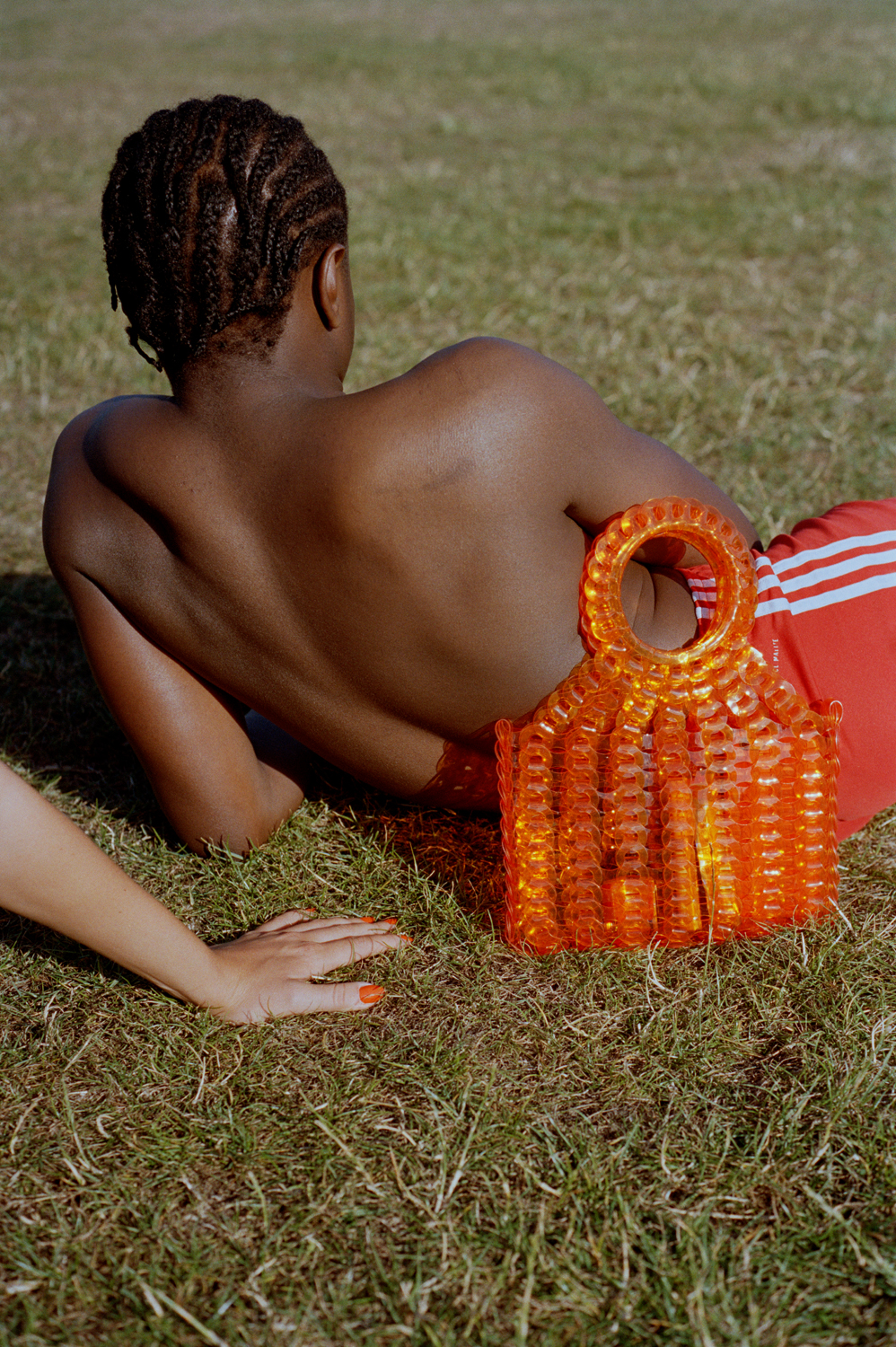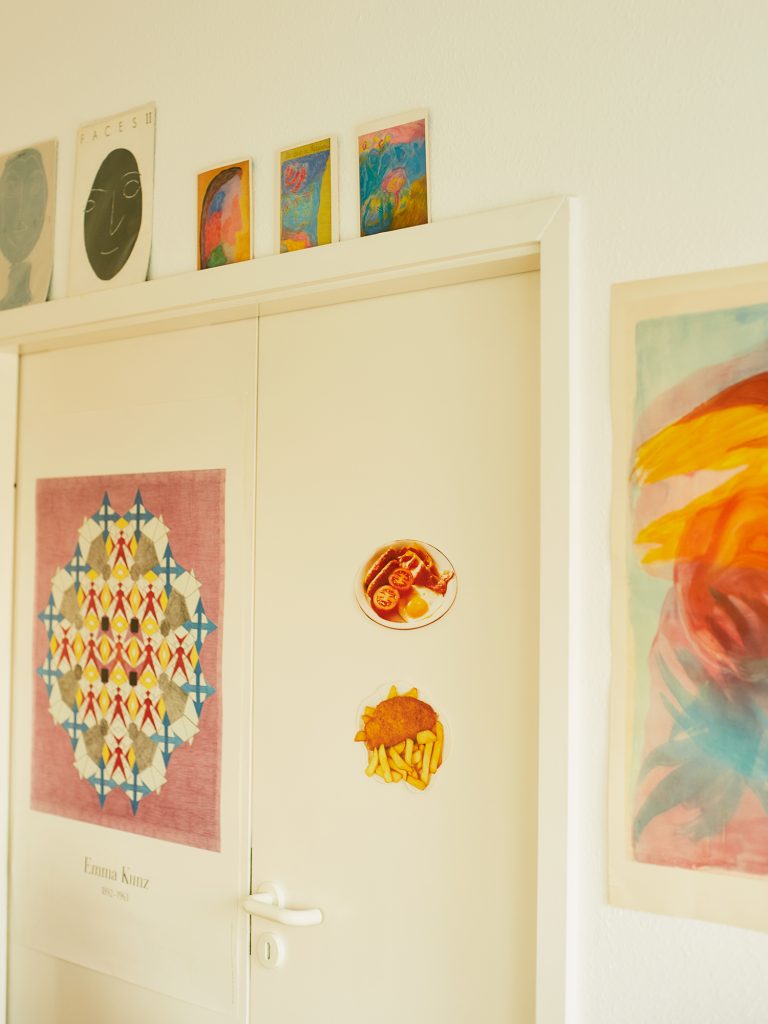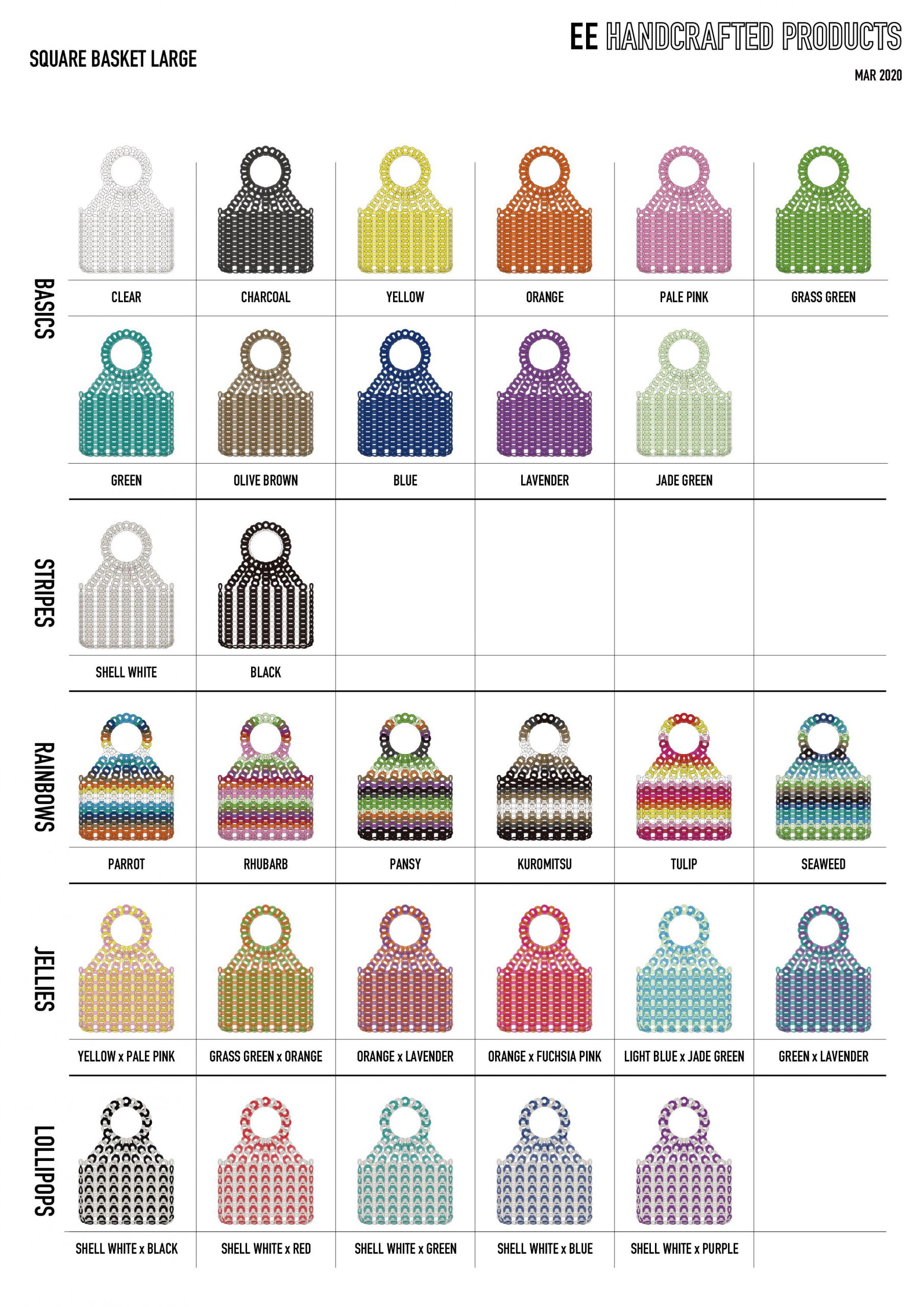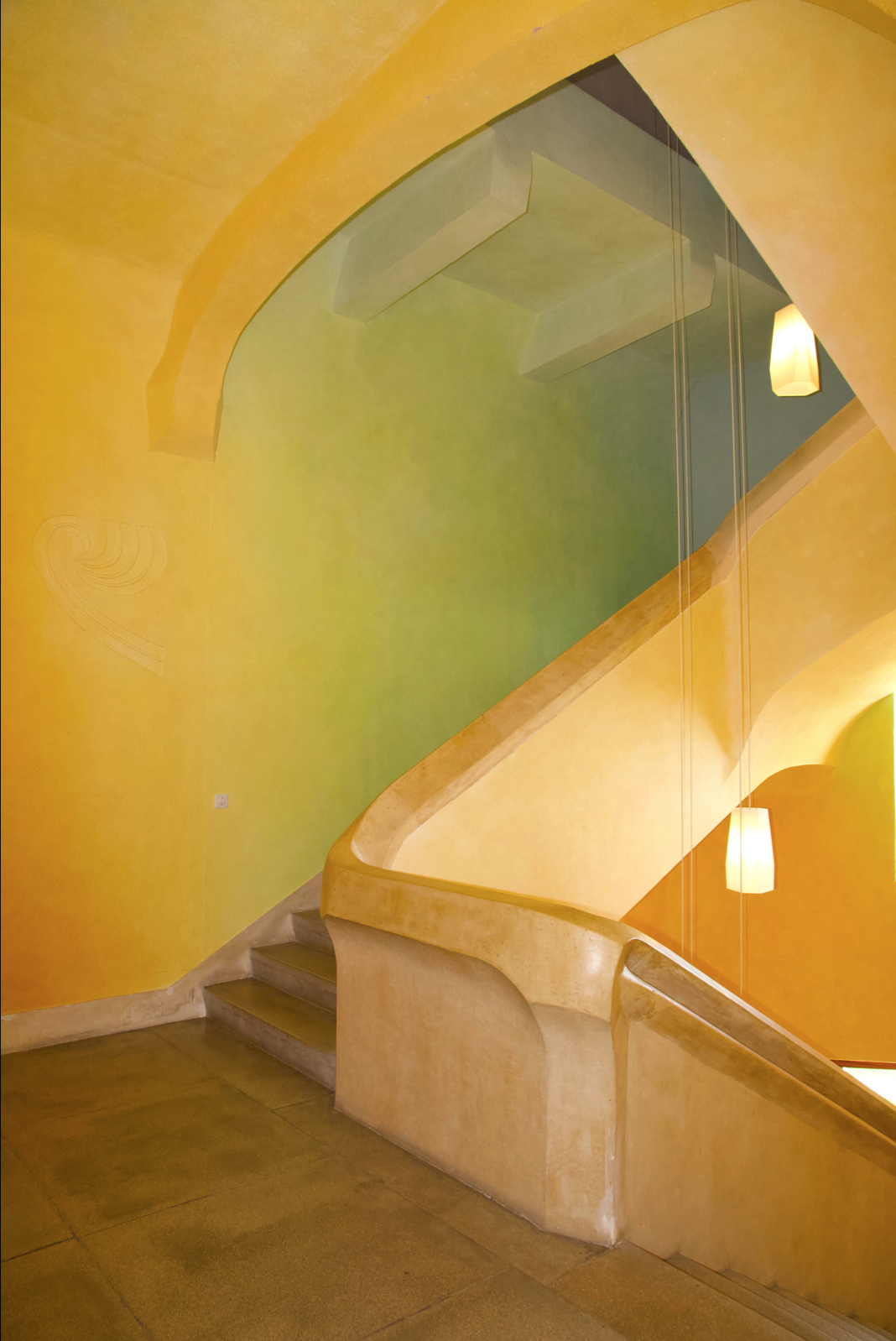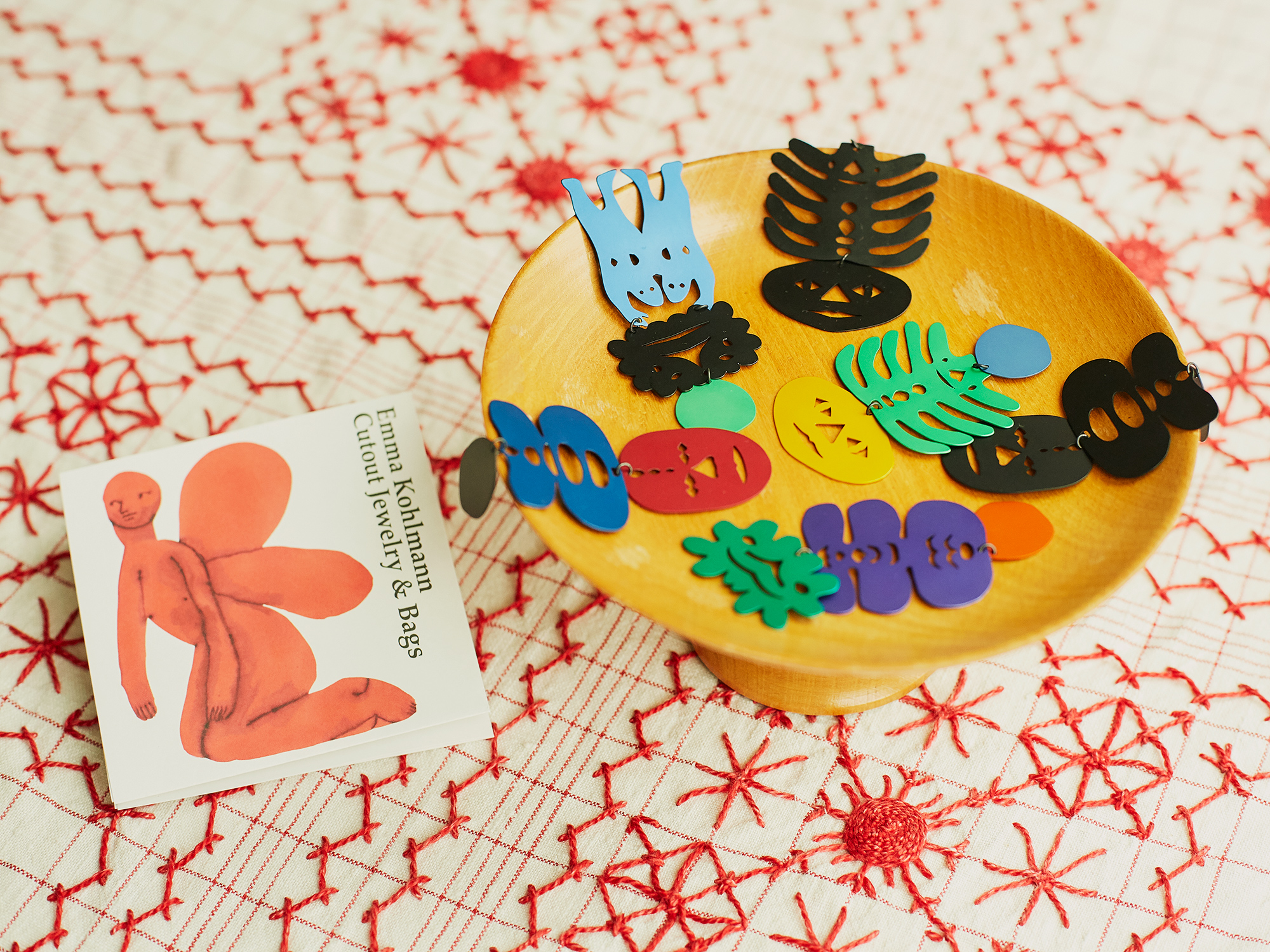With a variety of colors and a glossy, candy-like feel, EE HANDCRAFTED PRODUCT’s bags are small in size, but they have a special quality to them; just carrying one can lift your spirits. The label’s most recent products, a collection of accessories and bags born out of an encounter with Massachusetts-based artist Emma Kohlmann, were inspired by paper cutouts. EE HANDCRAFTED PRODUCTS, which appears like an avant-garde fashion brand at first glance, is a product label by two artists who are making what they want with their own hands. Now, three years since moving to Berlin, Emi Endo and Yohei Tomooka speak to TOKION about the world that lies behind their craftsmanship.
―― You started EE HANDCRAFTED PRODUCTS in 2018. That’s around the same time that you moved to Berlin, right?
Emi Endo (Emi): That’s right. I wanted to only do things that I actually wanted to do while living in Berlin. When I was thinking about what I could do with my background, and from anywhere, I came up with the idea to make a bag out of PVC parts with my own hands. I didn’t have much time until my move, so I made a sample right away, named it EE HANDCRAFTED PRODUCTS after my own initials [At the time of the label’s launch, the label was only Emi Endo], and started selling it at a Japanese select store. That’s how the label started.
――Would you say that your desire to move to Berlin came before your desire to start a label?
Emi: I hadn’t decided on Berlin, but I’d been thinking about moving to Europe for a while, so I’d quit my company and started preparing for that. It’s like once I quit, everything started, or I guess, it was like things got moving.
――I think you two had built successful careers for yourself in Japan—so why did you decide to move to Europe?
Emi: Back when I worked at a stationery brand from New York, they had exhibitions in New York, so I went there for business several times. It was America, so it wasn’t Europe, but from that time, I wasn’t thinking that I’d be exposed to the outside world and still only make products in Japan. Also, the March 2011 Great East Japan Earthquake was another big reason. From that point on, I felt a bit uneasy about living in Japan. But I changed jobs and such, so I ended up just continuing to work there. In 2017, the right time to quit my job presented itself, so I thought, “It’s now or never!” and decided to move.
Also, I studied textile design at Tama Art University, and I’d been interested in Europe’s art and music scenes since I was a student. I was influenced by Bauhaus and Droog, and I liked the work of Wiener Werkstätte and Scandinavian fiber artists, so I’d often look at their work.
Yohei Tomooka (Yohei): I studied product design at Tama Art University, and I’d loved European design since I was a student. Also, when I was working at Camper Japan as a bag designer, I had a lot of opportunities to go to the headquarters in Mallorca, Spain to give presentations, and also to communicate with the director in Mallorca. That exposed me to European values, so my experience at Camper also led to my move.
――So after all of that, you chose Berlin. But Berlin isn’t a fashion city like Paris or London, and there aren’t many Japanese people running brands out there. What’s that like? Is it easy to work there?
Emi: We didn’t want to do fashion—we wanted to create product designs that people could wear. So we don’t feel like, “We’re running a fashion brand in Berlin.” When I was at a company, I was exhausted from making a lot of products each season, and I also questioned the system of repeatedly producing, consuming, and discarding clothes. So I wanted to try doing something that could be done in a way that didn’t involve holding inventory. It doesn’t have much to do with Berlin. (laughs) I like living in Berlin, but to be honest, it’s not a city that strongly inspires us to make things. But from the aspect of focusing on production, I think it’s the perfect environment.
――I’m also guilty of thinking your brand was a bag brand at first, but as I saw at more of your work, I began to think that it’s better to see EE HANDCRAFTED PRODUCTS from another perspective, such as art, rather than categorize it in the framework of fashion.
Yohei: We spend most of our time in the residential neighborhoods of West Berlin. Throughout the city, there are a lot of old buildings called “Altbau,” and looking at them on our walks has become part of our daily routine. It’s also new for us to see the negative history preserved as art in the city. For example, on our walking route, there are some beautiful signs printed with graphics, and one day we wondered what they were and looked it up. It turns out they were monuments representing the restrictions placed on Jewish people through words and graphics. (The work is called “Orte des Erinnerns” by Renata Stih & Frieder Schnock) The monuments and Altbau are ubiquitous things, so they don’t influence our handcrafts right away, but I think they’ll remain as inspiration as we work in the future.
―― I’ve definitely seen them before around the city. I hadn’t thought of them as anything other than a part of the city’s art, so I didn’t realize they had that meaning. As with the case of Jewish people, Berlin has scars from the war throughout the city. We see these things without being aware of that, but it’s made me realize that there’s a really deep meaning and history there that we can’t understand. While many people focus on the cutting-edge culture in Berlin, the two of you have very unique perspectives and viewpoints that are really interesting.
Photography Hinata Ishizawa
Emi: When we were working at companies, and even now, we meet with craftsmen face-to-face as we make products, from the process of product development until mass production. So I didn’t want to be complicit in an industry where the efforts and hardships of these people are sold cheaply or discarded. So while we do get help from craftsmen and factories that can handle mass production, we basically use methods that allow us to make products with our own hands. That doesn’t require us to have a studio set up with large-scale equipment, so our method of working from home is also suitable for the environment.
――That’s very important. Today, people are paying attention to sustainability, and it’s said that we’re moving from a material society to a seishin-sekai [a New Age movement in Japan roughly translating to “spiritual world”].Yet, the problem of mass production remains. With that in mind, your PVC basket series is handcrafted carefully, one-by-one. I’d like to ask you about that. I think it’s a design that catches people’s eyes, and it’s become a sort of icon of your label. How did you come up with the idea?
Emi: It started when I spotted a ’70s brown leather bag from America at a vintage shop before moving. I happened to find the bag around the time I was wondering what to do in Berlin. I thought if I created a bag out of clear material using that vintage bag as a reference, it would be sparkly and pretty and came up with the idea of using PVC. At first, I started with monochrome designs, and just a few styles—around four to six. But now, when you combine the styles and patterns, we have over 100 kinds. We add patterns once every half year without a special seasonal theme.
Yohei: As for orders, everything is made to order, but unlike apparel brands with so-called made to order systems, we assemble the pieces with our own hands according to the orders from customers and stores. We have craftsmen make just the necessary number of pieces. Because of this production method, the basket bag series is unique in that there’s almost no risk of overstocking or waste even if we develop a lot of products.
――You mentioned there’s no particular seasonal theme, but is there anything that inspires your colorful use of color or patterns?
Emi: The rainbow color is a pattern that was inspired by a trip to Switzerland. There’s an area I like that’s scattered with Steiner architecture. I’ve already visited it about 4 or 5 times, and I even went there the first winter I spent in Berlin. Going from dark and grey Berlin to suddenly staying in a place overflowing with color, it was as if I were experiencing colors flowing into my body. There’s this dance called Eurythmy [an expressive movement art pioneered by Steiner] that the husband at the place I was staying took me to see. The color of the costumes change with the lighting and the movements of the dance, and it was so beautiful that it made me want to try expressing it in our products.
Until then, I’d only made monochrome or black and white bags, so I felt like it was color therapy for myself. I remember becoming completely engrossed in expressing the colors I saw in Switzerland through the products. My use of color and pattern-making, including the rainbow color, may be largely influenced by the fact that I specialized in textile studies as a student.
――It’s really beautiful. I never knew there was a place like that with Steiner architecture in Switzerland. Perhaps you’re able to get in touch with local cultures, like these kinds of places or dances, because you have sharpened senses. Your new series of accessories and bags are a collaboration with Massachusetts-based artist Emma Kohlmann. Was there a similar inspiration process there?
Emi: I’ve actually never met Emma in person, but we connected through Instagram by chance. I’d been thinking that the paper cutouts stuck up on the windows of Berlin’s kindergartens and such were cute, and thought that it’d be great to be able to wear something like that. That’s when I checked out Emma’s work and happened to see paper cutouts. I thought, “This is it!” From there, I reached out to her and immediately got an OK. Emma wasn’t making paper cutouts as part of her artwork, but she’d made them as decorations for a house party and had taken pictures of what was on the wall at her house.
Photography Hinata Ishizawa
――Maybe it was coincidence, or maybe it was fate, but in any event, it started from a connection that goes beyond national borders. I can imagine a texture that looks like colored paper and paper cutouts, but these products will have a completely different feel from the basket bag series that you’ve made until now, right?
Emi: In the first place, it wasn’t like I wanted to only make these bags, and it didn’t feel right to expand as a bag brand or to be seen as one. I’d been making the same bags since starting the label, but I was at a point where I was starting to feel a gap between what I was making and my love for Steiner architecture, the AltBau and ubiquitous monuments I mentioned earlier, and simple things.
Yohei: They have a different feel, but they’re connected in that we’re creating designs through familiar materials and making something that’s possible precisely because we’re using our hands. Emma liked the products too, so after that, the products were sold at V1 Gallery in Copenhagen, which represents Emma, and Emma herself also stocked the whole collection in her store.
――The line with Emma is at an accessible price point, which could allow it to spread quite quickly, and then this time you might be defined as an accessory brand. Once you have more works, if you held art or solo exhibitions instead of fashion exhibitions, maybe you two could convey the worldview behind what you’re doing.
Emi: I think we both think more like artists than designers in our work. We only do things we genuinely want to do, but as long as we’re making a living by creating and selling things, we try to make ends meet. But we can’t do things we don’t want to do just to grow the business or sell more. We were fed up with the system of fashion consumption based on a six-month cycle, so we decided to stop making products based on seasons in the future. We thought, isn’t that kind of thing actually pointless?
Yohei: For example, if you told someone that you liked apples, they may take it to mean that you like fruit. But it’s possible to like apples and dislike oranges, so I think it’s wrong to lump it all together as liking fruit in general. In the same way, I can’t help but feel uncomfortable when people categorize us as fashion designers or artists.
EE HANDCRAFTED PRODUCTS isn’t a label that specializes in sustainability. But when we deal with the things that feel wrong to us in our day-to-day lives, we naturally think about sustainability in our craftsmanship, and that’s reflected in the products. We aren’t making things that are just pop and colorful—our intention is to make products that are more multifaceted than that. We aren’t making things that are consistent and easy to understand as a label, and we don’t have many products yet, so we’re just getting started.
――I think the fact that everything is made to order without holding inventory, and handcrafted yourselves rather than made with machines already means you’re coming from a sustainable perspective. But there are all kinds of ways of thinking and definitions around sustainability, so not everyone will recognize that.
Emi: Our stance is that we don’t keep inventory because we don’t want to waste anything (we stock a small quantity of Emma’s bags), but once we’ve been criticized because PVC is plastic. But which is right? A brand that uses sustainable materials to mass-produce all kinds of products, and discards them, or handcrafting PVC bags in quantities that the two of us can handle? I can’t help but wonder. I think on some level, it’s not about it being good just because it’s organic cotton or recycled, or bad because it’s plastic.
Yohei: We’re not flaunting the handcrafted feel of our products, so sometimes people don’t understand that they’re handcrafted and think we’re mass-producing and holding inventory. Sustainability isn’t so simple—it’s more complicated than that.
For example, big manufacturers are increasingly switching over to sustainable materials for sneakers and such, but even in the transition process, they’re still producing things in mass quantities. There are the arguments of employment security and economic sustainability, so it’s reasonable, but if I think of it on an individual level, I think it’s inconsistent and I don’t personally feel it’s worthy of praise. Of course, we’d also like to transition to making things with environmentally low-impact materials to the extent that we can. Recently, we’ve been making our packaging materials plastic-free to the best of our ability. Since we’re using finite resources and people’s time for our work, we’re always thinking about social responsibility and trying to figure out what’s possible for us to do as a small-scale label.
Photography Mika Kitamura
――Right. There’s a limit to recycling plastic, and for example, even if you use leather, as long as you take good care of it with the intention of using it for life, isn’t that sustainability too? You two have expressed what you want to do in the form of the basket bag series and aluminum plate accessories, but I’m really looking forward to seeing what kind of ideas you come up with next.
Emi: We’re actually in the process of giving shape to a new idea now. Also, I think what Yohei and I have in common is that we’ve been exposed to materials since we were students and both of the brands we worked for in Japan were great with materials. Rather than creating a design, it’s more like we start from the materials, then from there we think of what to make, and mix the arts or crafts that we like, or what we feel is wrong with the world at that time. And that mix is what makes EE HANDCRAFTED PRODUCTS. Making high-end bags with high-end leather doesn’t appeal to us. In the first place, there are a lot of beautiful materials that I already know and am familiar with but have overlooked, and I often think that I want to make things with those kinds of materials.
For example, the technique we used to create Emma’s aluminum accessories is the same technique used to create kettles. It’s fun to see materials like that become something beautiful, and that’s the charm of materials.
Yohei: It’s really interesting to see the value of materials change. I think that’s an important power that design has.
Emi Endo
Emi Endo graduated from Tama Art University’s Department of Production and Textile Design with a major in Textile Design in 2009. After graduation, she began working at a paper and leather goods brand from New York. In addition to being in charge of product design, she was involved in collaborations with artists and exhibition planning. In 2015, she began working at ISSEY MIYAKE INC., where she was in charge of bag and accessory design. After leaving the company in 2017, she and Tomooka began working on designs as a design duo under the name of EETY, where they created design proposals for material manufacturers. In the spring of 2018, she made use of her background and launched EE HANDCRAFTED PRODUCTS, a label that combines mass production techniques with handcraft work, and moved to Berlin. She currently works between Berlin and Tokyo.
Yohei Tomooka
Yohei Tomooka graduated from Tama Art University’s Department of Production and Textile Design in 2012 with a major in product design. After graduation, he began working at PINA INC. (now Camper Japan Inc.) He was in charge of designing bags and accessories for the Spanish shoe brand Camper. He also proposed collaboration plans and worked on product development with artists. After leaving the company in 2017, he worked as part of EETY, and in 2018, he joined EE HANDCRAFTED PRODUCTS, where he was involved from the collaboration plan to the design with Emma Kohlmann.
Translation Aya Apton


